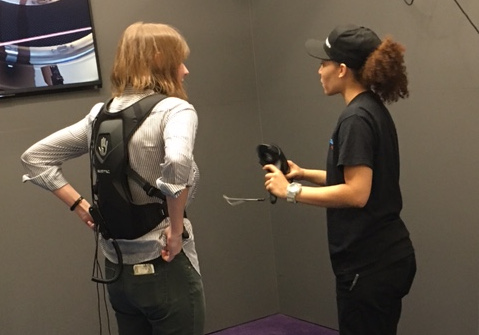Had an unforgettable experience during my NYC tour with Vibe NYC Tours, and one of the highlights was checking out the IMAX VR Center at AMC's Kips Bay! The immersive VR experience was a game-changer—feeling the action with haptic vests and totally losing myself in virtual worlds was next-level. If you’re in NYC, don’t miss out on this amazing new way to experience entertainment!
IMAX Opens Virtual Reality Center In NYC
IMAX and theater operator AMC gathered the press for a tour and first-hand demo of the IMAX VR Experience Center last week at AMC's Kips Bay 15 multiplex in the swanky Murray Hill neighborhood of Manhanttan's East Side. The IMAX VR complex, located in the theater's main lobby, consists of 12 individual "pods"—essentially walled-in cubes with an open front. VR headsets, haptic vests that provide tactile sensations to the wearer's back and chest, surround sound headphones, and various interactive controllers allow customers to fully immerse themselves in customized virtual reality content created by IMAX in conjunction with its content partners. Although some of the VR experiences offered, such as a virtual roller-coaster segment, are more "sit-back," most involve roaming or otherwise moving around inside an approximately 8 x 8-foot space. Flatscreen monitors in each pod allow friends and passersby to observe the virtual action. The typical experience lasts 7 to 12 minutes, with pricing at about $1 per minute. Each pod also has a trained attendant on duty to assist customers.
IMAX Corp. CEO Richard Gelfond explained to assembed reporters that the effort grew out of the firm's research into VR as an emerging entertainment area, and the conversations they had with many of today's leading technology providers who were pitching their solutions. "We kept hearing over and over again that this or that was 'the IMAX of VR,' " Gelfond said, referring to the company's earned reputation as a premium cinematic experience. "We figured that if someone was going to be the IMAX of VR, it might as well be IMAX."

The company opened its first center, a dedicated space in Los Angeles, in January. But the Kips Bay center is the first inside a cinema and as such is a critical pilot location for what's expected to be a worldwide rollout. IMAX and AMC, the firm's largest exhibition partner, are acutely aware of the need to draw younger audiences, particularly millenials and Gen Z'ers, out to the cinema. The hope is that a new experience and the social aspect of the amusement arcade-like centers&mash;which allow a group of friends to gather and each try their turn at shooting bad-guys or performing a balancing act while the others look on—will bring them in. IMAX executives indicated that, so far, 70% of the visitors to their Los Angeles facility had no prior experience with virtual reality.
The VR headsets used in the pods were the HTC Vive or the Starbreeze Star VR, the latter of which is known to have a wider field of view. The content runs from customized verisons of popular video games, such as Raw Data, to movie-themed experiences. Content providers include studios and game companies such as ILMxLABs, Sony, Lionsgate, VRC, Starbreeze, Survios and Ubisoft.
The opening of the Center and its inclusion of Starbreeze’s Mummy Prodigium Strike marked a day-and-date release of a VR experience with the theatrical film opening of The Mummy remake, something IMAX expects to do more of. Other upcoming content for the Kips Bay facility include Ubisoft's Star Trek Bridge Crew and Skydance's Archangel. Critically, IMAX has raised a $50 million IMAX VR Fund to develop fresh material and has already greenlit its first project with Bullit, a creative collective of successful filmmakers.

Among the three VR experiences I tested personally, I found the Raw Data demo to be the best. After being equipped with a haptic vest, headphones, and HTC Vive VR headset and gun/holster controllers, I was set loose to defend myself against a seemingly endless barage of full-size humanoid robots intent on destroying me. Unlike several prior VR solutions I've tried, the head-, hand-, and body-tracking were dead-on responsive, with virtually no nauesa-inducing lag, and the 3D virtual space remained crisp and in sharp focus no matter where I turned. By comparison, my experience attempting a Vive-driven tightrope walk between the old Twin Towers, based on the 2015 movie about Philippe Petit's famous stunt, was exhilarting in its natural (apparently, photo-realisitic) rendering of the scenery, but lacked the sharp focus that would have put me more fully in the scene in the way Raw Data did.
The Starbreeze-powered Mummy Prodigium Strike turns visitors into a mummy-shooting commando and begins with sitting on a specially-designed bench that moves to mimic the motion and vibration you might feel sitting in the edge of an open helicopter hatch, automatic machine gun in hand. While the videogame-like rendering was highly engaging and immersive, especially with the Starbreeze glasses' wide view, I found the glasses a less-than-perfect fit for my head, resulting in some lack of focus and a bit of annoying error between the eye pieces that would have ultimately limited how much time I could spend in the virtual space. It wasn't enough to not recommend the experience to someone else, especially given my own hypersensitivity to such imperfections, but overall my the three experiences did drive home for me that there remains some inconsistency in the delivery of VR based on the equipment used and the content itself—even in a highly curated situation like this that's intended to commercialize VR and show off the true state-of-the-art. I'm sure the feedback IMAX gets from consumers will help inform and improve both the technology and the content going forward.
- Log in or register to post comments




























































